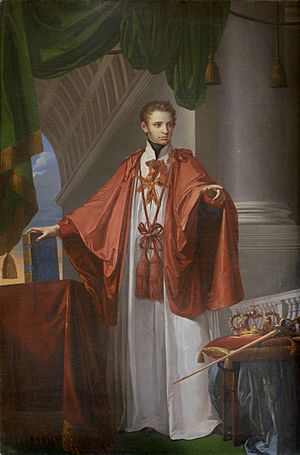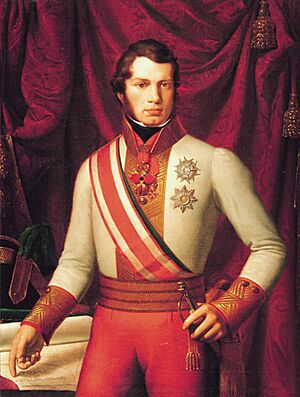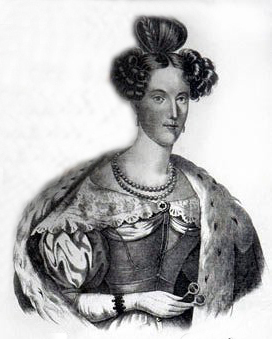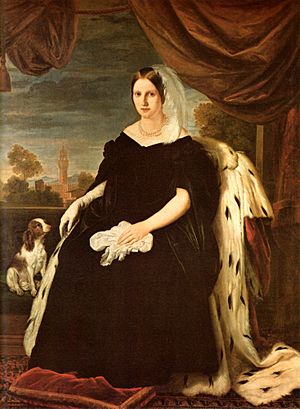Leopold II, Grand Duke of Tuscany facts for kids
Quick facts for kids Leopold II |
|||||
|---|---|---|---|---|---|

Portrait of Leopold II, by Giuseppe Bezzuoli
|
|||||
| Grand Duke of Tuscany | |||||
| Reign | 18 June 1824 – 21 July 1859 | ||||
| Predecessor | Ferdinand III | ||||
| Successor | Ferdinand IV | ||||
| Born | 3 October 1797 Florence, Tuscany |
||||
| Died | 29 January 1870 (aged 72) Rome, Papal States |
||||
| Consort | Princess Maria Anna of Saxony (m. 1817; died 1832) Princess Maria Antonia of the Two Sicilies (m. 1833) |
||||
| Issue Detail |
|
||||
|
|||||
| House | Habsburg-Lorraine (initially) Habsburg-Tuscany (founded) |
||||
| Father | Ferdinand III, Grand Duke of Tuscany | ||||
| Mother | Princess Luisa of the Two Sicilies | ||||
| Religion | Roman Catholicism | ||||
Leopold II (born October 3, 1797 – died January 29, 1870) was the Grand Duke of Tuscany. He ruled from 1824 to 1859. He was known as a fair and open-minded ruler. He even allowed a new constitution in 1848 and some freedom for newspapers.
Leopold was married twice. His first wife was Maria Anna of Saxony. After she passed away in 1832, he married Maria Antonia of the Two-Sicilies. His son, Ferdinand, later became his successor.
In 1849, a temporary government briefly removed Leopold from power. But he returned later that year with help from Austrian soldiers. These troops stayed in Tuscany until 1855. Leopold tried to stay neutral during the Second Italian War of Independence. However, he was forced to leave Tuscany in 1859. This happened just before the war began. The Grand Ducal family went to Bologna.
Tuscany was then taken over by soldiers from Victor Emmanuel II of Sardinia. An agreement was made for the family to return to Florence. But Leopold was not popular enough to be accepted. So, on July 21, 1859, he gave up his throne to his son, Ferdinand. Yet, Ferdinand was also not accepted by the people. The temporary government then announced that the House of Habsburg family was no longer in charge.
Contents
Leopold's Early Life and Rule
Leopold II was born in Florence. His parents were Ferdinand III, Grand Duke of Tuscany and Princess Luisa Maria Amelia Teresa of the Two Sicilies. They were cousins. His grandparents were Ferdinand I of the Two Sicilies and Marie Carolina of Austria.
He became Grand Duke on June 18, 1824, after his father. For the first 20 years, he focused on improving Tuscany. His rule was seen as one of the most gentle in Italy at the time. He allowed a good amount of freedom for the press. He also let political exiles from other states live in Tuscany without trouble.
Changes and Challenges
In the 1840s, people across Italy started asking for more freedom. Even in Tuscany, people wanted a constitution and other political changes. There were riots in 1845 and 1846. Leopold made some changes to how the government worked. But Austrian influence stopped him from doing more.
When Pope Pius IX was elected, it encouraged people who wanted more freedom. On September 4, 1847, Leopold created the National Guard. This was a step towards a constitution. Soon after, Cosimo Ridolfi became prime minister. Tuscany then got its own constitution on February 17, 1848. This was written by Gino Capponi.
The 1848 Revolutions
Uprisings in Milan and Vienna made people in Tuscany feel very patriotic. They demanded war against Austria. Leopold agreed to this public pressure. He sent soldiers and volunteers to help Piedmont in the Lombard campaign.
Leopold gave a strong speech when the troops left. He said the fight for Italian freedom was happening in Lombardy. He praised the citizens of Milan for their bravery. He ended by saying, "Long live Italian independence!" The Tuscan soldiers fought bravely.
On June 26, the first Tuscan parliament met. But the war in Lombardy did not go well. This led to the Ridolfi government stepping down. Gino Capponi's government took over. Riots continued, especially in Livorno, where there was civil war. The democratic party, led by Francesco Domenico Guerrazzi and Giuseppe Montanelli, grew stronger.
Capponi resigned, and Leopold reluctantly agreed to a Montanelli-Guerrazzi government. This new government then had to fight against extreme republicans.
Leopold's Return and Final Abdication
New elections in 1848 led to a parliament that wanted a "constituent assembly." This assembly would create a new government. There was talk of making Leopold king of a central Italian kingdom. This kingdom would be part of a larger Italian federation.
However, Leopold became worried about the revolutionary groups in Tuscany. He was also encouraged by Austrian military successes. He started talking with Austrian Field Marshal Radetzky and Pope Pius IX. The Pope had also stopped supporting liberal ideas.
Leopold left Florence for Siena, then for Porto Santo Stefano. He left a letter saying he could not agree to the assembly. Florence and other parts of Tuscany were in chaos. On February 18, 1849, a republic was declared. Leopold sailed away to Gaeta. A new parliament was elected, and Guerrazzi was made dictator.
But many people were unhappy. When Charles Albert lost at Novara, it worried the liberals. Most people wanted the Grand Duke to return. In April 1849, the city council asked him to come back. They hoped he would restore the monarchy and save them from foreign invasion.
Leopold agreed. He sent Count Luigi Serristori to Tuscany. But at the same time, the Austrians took over Lucca and Livorno. It was later shown that Leopold had asked for Austrian help. On May 24, Leopold appointed G Baldasseroni as prime minister. On May 25, the Austrians entered Florence. Leopold himself returned on July 28.
In 1850, he made a deal with Austria to keep Austrian troops in Tuscany. In September, he closed parliament. The next year, he made an agreement with the Church that gave it a lot of power. He asked Austria if he could keep the constitution. But the Austrian leader told him to ask the Pope and other Italian rulers. Following their advice, he officially canceled the constitution in 1852.
Many political trials were held. Guerrazzi and others were sent to prison. Even though Austrian troops left Tuscany in 1855, Leopold was no longer popular. Some liberals still hoped he would join Piedmont in a war against Austria. But others believed that Leopold had to leave for Italy to unite.
In 1859, France and Piedmont went to war with Austria. Leopold's government could not stop young Tuscan volunteers from joining the Franco-Piedmontese forces. Finally, a deal was made between different political groups. They formally asked the Grand Duke to join the war.
Leopold at first agreed. He asked Don Neri Corsini to form a new government. The people wanted Leopold to give up his throne to his son. They also wanted an alliance with Piedmont and for Tuscany to be part of a united Italy. Leopold thought about it but finally refused. He felt these demands were against his honor.
On April 27, there was great excitement in Florence. Italian flags were everywhere. But everything remained peaceful. The Grand Duke and his family left for Bologna without any trouble. This was a revolution without bloodshed. After a time of temporary government, Tuscany joined the Kingdom of Italy. On July 21, Leopold gave up his throne to his son, Ferdinand IV of Tuscany. Ferdinand never actually ruled.
Leopold's Legacy
Leopold of Tuscany was a kind and well-meaning person. He cared more for his people than other Italian rulers. But he was not strong enough. He was too tied to his family and Habsburg traditions to truly be a liberal leader. If he had not asked for Austrian help in 1849, he might have kept his throne. He might even have changed Italian history.
Leopold and his wife helped start L'Istituto Statale della Ss. Annunziata. This was the first boarding school for noble young ladies in Florence. Leopold also ordered the building of La Botte. This was a water tunnel under the Arno river. It helped drain the Lago di Bientina, which was the largest lake in Tuscany. La Botte was finished in 1859. It is still an important part of Tuscany's water system today.
Leopold spent his last years in Austria. He passed away in Rome on January 29, 1870.
Family Life
Leopold married Princess Maria Anna of Saxony in 1817. They had four children:
- Archduchess Carolina Auguste Elisabeth Vincentia Johanna Josepha (1822–1841)
- Archduchess Auguste Ferdinande of Austria (1825–1864); she married Luitpold, Prince Regent of Bavaria.
- Archduchess Maria Maximiliana Thekla Johanna Josepha (1827–1834)
- Archduchess Maria Josepha Amalia Carlotta Giovanna (1828–1836)
Maria Anna passed away in 1832. In 1833, Leopold married Maria Antonietta of the Two Sicilies. She was his cousin. They had ten children:
- Archduchess Maria Isabella of Austria; she married her uncle Prince Francis, Count of Trapani.
- Ferdinand IV, Grand Duke of Tuscany (1835–1908)
- Archduchess Maria Theresia Annunziata Johanna Josepha Paulina Luisa Virginia Apollonia Philomena (1836–1838)
- Archduchess Maria Christina Annunziata Agatha Dorothea Johanna Josephina Luisa Philomena Anna (1838–1849)
- Archduke Karl Salvator of Austria (1839–1892); he married Princess Maria Immaculata of Bourbon-Two Sicilies.
- Archduchess Maria Anna Karoline Annunziata Johanna Josepha Gabriela Theresia Katharina Margarethe Philomena (1840–1841)
- Archduke Rainer Salvator Maria Stephan Joseph Johann Philipp Jakob Antonin Zenobius Alois von Gonzaga (1842–1844)
- Archduchess Maria Luisa of Austria (1845–1917); she married Karl, Prince of Isenburg-Büdingen.
- Archduke Ludwig Salvator of Austria (1847–1915)
- Archduke Johann Salvator of Austria (1852–reported lost at sea in 1890)
See also




